Boletus L.
Recent molecular studies have shown that Boletus in its current circumscription is likely an artificial grouping and it is possible that it will be split at some point into smaller genera. Note that Boletus impolitus and Boletus depilatus for practical reasons are retained here, although there is strong evidence that they are closely related to Xerocomus subtomentosus and its allies.
Fruitbody large to medium sized, boletoid, without veil and ring. Stipe solid, with surface usually covered with granules or network. Flesh variously coloured, changing or not when exposed to air. Tubes easily separable from each other, not tearing apart. Pores usually small and rounded.
Boletus lupinus Fr.
Description
Pileus up to 15 cm, convex to flat-convex or almost flat, dry, smooth, initially whitish, pale grey or very pale ochraceous and tinted red at the cap margin, later with strongly developing pinkish tint, finally almost entirely pale pink, pink, dark pink or reddish pink, often spotted darker. Stipe club-shaped, cylindrical or bulbously swollen, often tapering towards the base, almost entirely pale or bright yellow, discolouring to yellowish, often tinted orange red or reddish in places, in the upper part covered with very fine yellow granules, downwards almost smooth. Flesh lemon yellow, blueing when exposed to air. Tubes lemon yellow to yellow with olivaceous tint, blueing when injured. Pores red or orange red, blueing when bruised. Smell not distinctive. Taste not distinctive. Spores 11–15 × 5–6 μm, ratio 2–2.5. Pileipellis (the cap cuticle) a trichodermium of interwoven septate hyphae of cylindrical, finely incrusted cells. Chemical reactions: hyphae of the flesh in the stipe base inamyloid with Melzer’s reagent.
Habitat. Warm broadleaf forests, mycorrhizal with oaks (Quercus) and sweet chestnut (Castanea).
Distribution. Southern species, that is more common in the Mediterranean area and is absent in Northern Europe.
Similarity. Fruitbodies with red caps may resemble Boletus dupainii, but the later has numerous fine red dots allover the stipe surface, while the stipe in B. lupinus is mostly yellow. Boletus queletii may probably sometimes look similar, but it has vinaceous flesh in the stipe base and amyloid hyphae.
Photographs
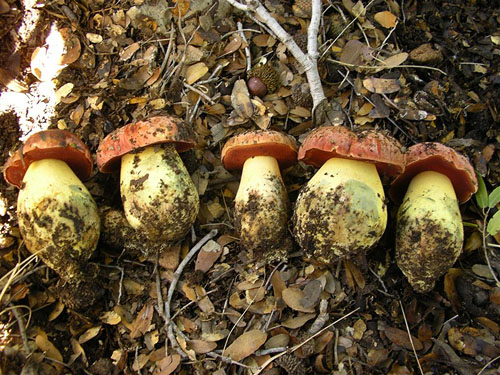
Rich collection of Boletus lupinus. Note the variability of the shape of the stipe. (photo Z. Shafranov)

Fragment of the same collection of Boletus lupinus. Note the coulours of the stipe and the cap. (photo Z. Shafranov)
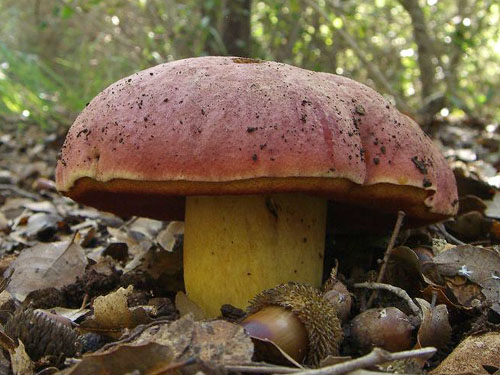
Well developed fruitbody of Boletus lupinus. (photo R. Kuznetsov)

Young fruitbody of Boletus lupinus. (photo R. Kuznetsov)
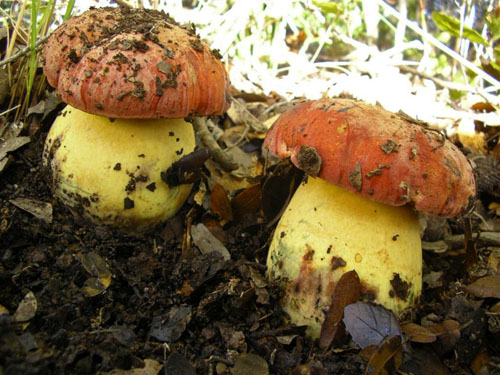
Young fruitbodies of Boletus lupinus. The overall colours may sometimes resemble Boletus dupainii, the yellowish coloured stipe is distinguishing character in the field. (photo Z. Shafranov)
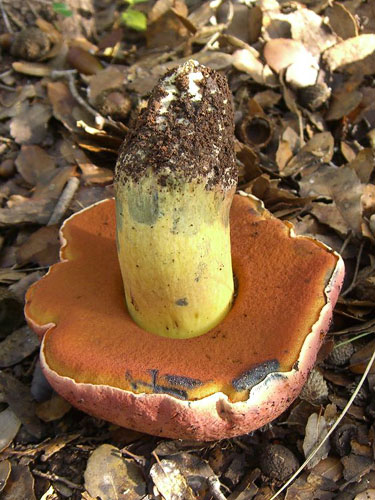
Fruitbody of Boletus lupinus - lower side. (photo R. Kuznetsov)
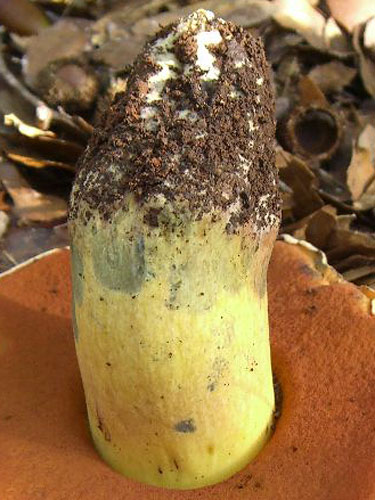
Boletus lupinus - detail of the stipe surface. (photo R. Kuznetsov)
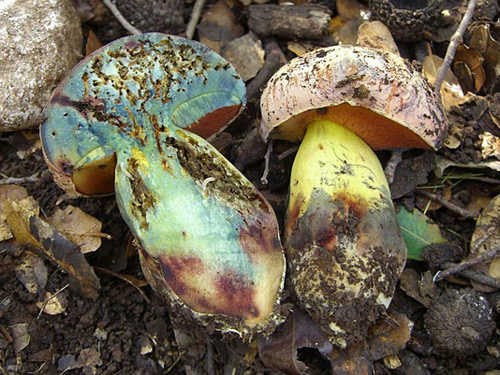
Sectioned fruitbody of Boletus lupinus. (photo R. Kuznetsov)
Important literature
Alessio, C.L. 1985. Boletus Dill. ex L. (sensu lato). – In: Fungi Europaei. Vol. 2. Pp. 1–705. Libreria editrice Biella Giovanna, Saronno.
Engel, H., Krieglsteiner, G., Dermek, A. & Watling, R. 1983. Dickröhrlinge. Die Gattung Boletus in Europa. Verlag Heinz Engel, Weidhausen b. Coburg.
Estadès, A. & Lannoy, G. 2004. Les bolets européens. – Bulletin Mycologique et Botanique Dauphiné-Savoie 44(3): 3–79.
Galli, R. 1998. I Boleti. Atlante pratico-monographico per la determinazione dei boleti. Edinatura, Milano.
Lannoy, G. & Estadès, A. 2001. Les Bolets. Flore mycologique d’Europe. Documents Mycologiques Mémoire Hors série no. 6. Pp. 1–163. Association d’Écologie et de Mycologie, Lille.
Muñoz, J.A. 2005. Boletus s. l. – In: Fungi Europaei. Vol. 1. Pp. 1–951. Edizioni Candusso, Alassio.
Pilát, A. & Dermek, A. 1974. Hríbovité huby. Československé hríbovité a sliziakovité huby (Boletaceae – Gomphidiaceae). Veda, Bratislava.
Šutara, J., Mikšík, M. & Janda, V. 2009. Hřibovité houby. Čeled’ Boletaceae a rody Gyrodon, Gyroporus, Boletinus a Suillus. Academia, Praha.